 Poverty is one of the most pressing concerns facing the globe today. How poverty exacerbates many issues indicates the importance of achieving Sustainable Development Goal (SDG) 1. Following the conclusion of the Millennium Goals in 2015, the United Nations created the 17 SDGs to provide a framework for achieving development by 2030. The first SDG put forth by the U.N. is no poverty and concerns both extreme poverty and the poverty line. Sudan has been fighting poverty for decades and according to the SDG index trends are continuing to decrease with already concerning levels of poverty throughout the country. This article unpacks the updates on SDG 1 in Sudan and the path to achieving no poverty.
Poverty is one of the most pressing concerns facing the globe today. How poverty exacerbates many issues indicates the importance of achieving Sustainable Development Goal (SDG) 1. Following the conclusion of the Millennium Goals in 2015, the United Nations created the 17 SDGs to provide a framework for achieving development by 2030. The first SDG put forth by the U.N. is no poverty and concerns both extreme poverty and the poverty line. Sudan has been fighting poverty for decades and according to the SDG index trends are continuing to decrease with already concerning levels of poverty throughout the country. This article unpacks the updates on SDG 1 in Sudan and the path to achieving no poverty.
Updates on SDG 1 in Sudan
The United Nations SDG index ranks Sudan 159th out of 166 countries included in the index analysis. The U.N. identifies that Sudan has major challenges remaining with decreasing trends in terms of achieving no poverty. This indicates that poverty in Sudan is not only extreme but continues to worsen every day. Based on data analytics from the United Nations SDG Index, the percentage of the population in Sudan living in extreme poverty has been steadily increasing from 12.5% in 2016 to 26.98% in 2024, the highest rate since 2000, according to the Sustainable Development Report.
According to the World Poverty Clock, 29% of people in Sudan are living on $2.15/day or less. On top of that, 52% of the population lives on $3.65/day, at or below the poverty line. https://worldpoverty.io/ Furthermore, according to a 2021 UNICEF analysis child poverty rates increased from 12% to 85% between 2014 and 2020.
GDP and Poverty Rates
A 2024 World Bank datasheet on poverty in Sudan explains that GDP could decrease by 3.5% after decreasing by 12% in 2023 due to the collapse of government institutions and conflict throughout the country. The conflict has disrupted public spending and reduced the country’s tax base which has consequently increased poverty rates as data from the World Poverty Clock and the SDG Index indicate. Thus the progress toward SDG 1 in Sudan has seen a negative impact from economic instability and conflict.
Life in Poverty
The interconnectedness of each of the SDGs brings about the discussion of how poverty impacts other aspects of life and development. Life in poverty heavily influences all other aspects of living and is reflected in the progression of many other SDGs.
Education in Sudan is an example that is largely related to patterns of poverty. As of 2018, only 77% of children of the official school age are enrolled in primary education and the participation rate in pre-primary organized learning is just 38.63%. Such information indicates the relationship between poverty and education thus deepening the importance of tackling global poverty as taking action towards one SDG will positively impact others.
The Future
To combat the rising poverty rates, the International Rescue Committee (IRC), along with many other NGOs and foreign aid programs, have identified Sudan as a high-priority concern. As an NGO dedicated to supporting developing countries and their citizens, the IRC has set up and strengthened operations in the Blue Nile, White Nile, and Gaderef states in Sudan to support and bring humanitarian aid to the 25 million Sudanese that need humanitarian aid, the 8.2 million that have been forcibly displaced and the 18 million that are facing crisis levels of food insecurity.
In 2021, the Commission on Social Safety and Poverty Reduction under the Ministry of Social Development launched the Mothers and Child Cash Transfer Plus Program (MCCT+) to support mothers and children affected by poverty. The flagship program in Sudan actively supports those in need with cash provisions, sharing information, and care of women and children and has supported 50,000 pregnant women in just the first phase of the program.
Overall, these updates on SDG 1 in Sudan highlight the troubling situation for the Sudanese people. Poverty rates across the country have continued to rise along with growing economic instability, a declining GDP and its negative influence on education. However, it is with support from foreign aid, government initiatives like the Mothers and Child Cash Transfer Plus program and NGO’s like the IRC that bring hope to Sudan and make progress possible.
– Juliana Granville
Juliana is based in Broooklyn, NY, USA and focuses on Politics for The Borgen Project.
Photo: Flickr






 Poverty in the Central African Republic is an ongoing problem showing few signs of improvement. Despite being abundant in natural resources, the nation is one of the poorest and most economically fragile countries in the world. As of 2022, approximately
Poverty in the Central African Republic is an ongoing problem showing few signs of improvement. Despite being abundant in natural resources, the nation is one of the poorest and most economically fragile countries in the world. As of 2022, approximately  Access to good health care and proper medication is a problem for many countries. Nearly
Access to good health care and proper medication is a problem for many countries. Nearly 
